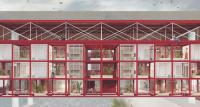An Idea on How to Solve the Housing Crisis in Los Angeles
Students from the Faculty of Architecture won the third prize in the Affordable Housing Challenge competition. The task for participants was to design affordable housing facilities in Los Angeles.
The Affordable Housing Challenge is an international competition organized by the Buildner platform in collaboration with Archive Books. The challenge is to develop projects for affordable housing solutions in a specific location. Each edition features a different location, which also influences various local requirements. The latest edition of the competition focused on Los Angeles, which is struggling with rapidly rising rents, gentrification, and expensive houses.
The third place in the architectural competition was won by students from the Warsaw University of Technology – Zuzanna Bućko and Alona Usychenko. In their concept, they focused on underutilized spaces along the river in the "City of Angels".
The T.R.U. (Thrive Revive Unite) project embodies the ideas of development, revitalization, and unity. It combines a commitment to providing optimal living conditions, rejuvenating the Los Angeles River and its surroundings, and creating pedestrian-friendly connections and a vibrant community.
– We want to utilize the spaces along the river, with special emphasis on the areas under bridges. Currently, they are neglected and dominated by industrial facilities, yet they hide great potential – say the authors of the concept. – Our project fits perfectly into the general plan of the Los Angeles River, enriching the vision by introducing affordable residences – they add.
The building proposed by the students is adapted to diverse age and demographic groups, allowing residents to modify and adapt the space to individual needs.
Each apartment comes with a private, green terrace. Common spaces inside the building and the surrounding greenery contribute to a sense of community.
The affordability of the solutions comes from the ability to adapt the apartments to any plot, which reduces land acquisition costs. Ground floor spaces designated for social use, which can be rented out to local businesses, provide an additional source of funding for social initiatives. Efficient delivery and production of prefabricated elements, combined with the ease of modifying the structure depending on specific needs, contribute to the economic accessibility of the project.
– Our project is not only a response to the housing crisis but a holistic urban intervention that seamlessly integrates with revitalization efforts, promoting sustainable development, community engagement, and economic profitability – emphasize our students.
For more information about the competition and the awarded projects, visit: architecturecompetitions.com.








